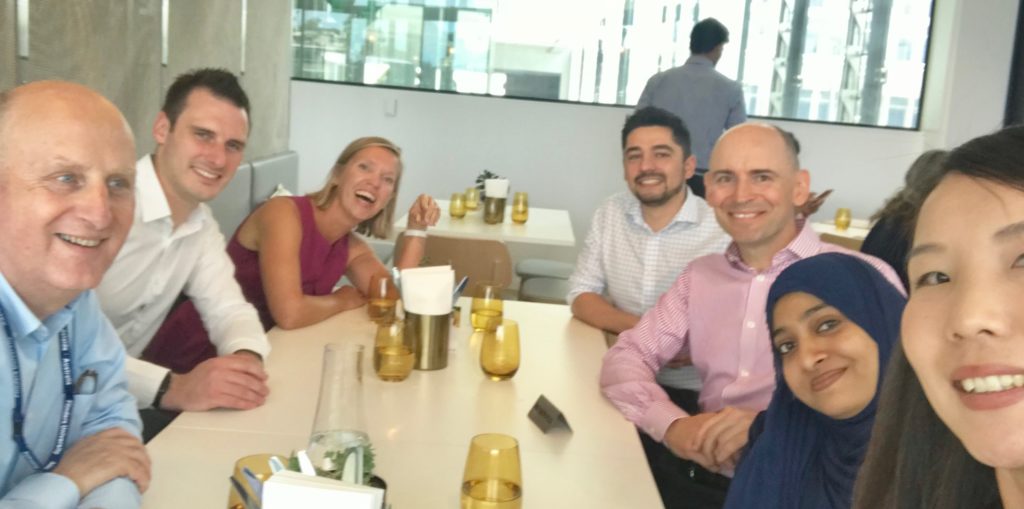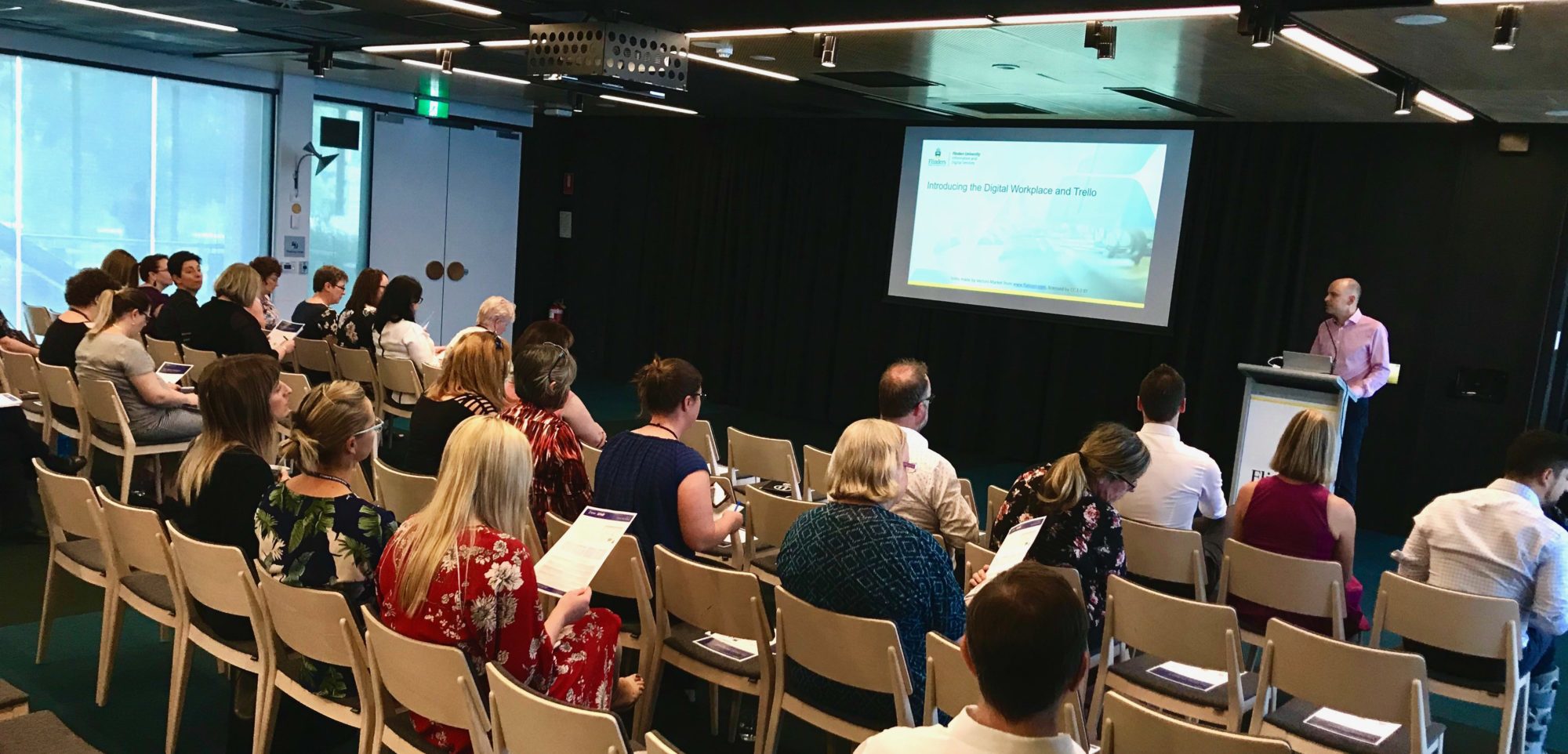I’ve written a few times about the Digital Workplace project that I’ve been the Product Owner for this year, and it gave me great pleasure to be part of the launch team this week as we rolled out the first phase of our ‘product’ – Trello. But when the tool you’re launching is already freely available, and you know that plenty of people have already started using it, then what exactly is there to launch?
This project has been a fascinating journey of discovery trying to answer this question, and it has been a deep can of worms indeed.
We knew what we wanted to do from the outset – work out a way that we could make life easier for staff at the University in the tools they used to perform three common functions – communication, collaboration and coordination of their work.
We also knew about the mistakes of the past, primarily that more tools and more choice don’t necessarily equate to an easier day in the office, in fact it can mean exactly the opposite.
more tools and more choice don’t necessarily equate to an easier day in the office, in fact it can mean exactly the opposite
You can read more about the vision and goals of the project here, but to sum up, we agreed early on that what we were trying to do was to provide staff with a set of daily workday tools (nestled in alongside email, of course) which provided the most benefit using the fewest tools and ensuring that any tools we recommended (note – not mandated) had the proper learning structures in place, the right technical support, and that the tools themselves were ‘enterprise ready’.
Living Agile
What we didn’t quite know was how the whole scenario would play out. How would we select tools? What would our learning and support model need to look like to help end users? What did we need to do to help change behaviours in positive ways to deliver the most benefit from the tools? How would we know if we were actually making a positive impact?
Making it to the official launch of Trello incorporated a lot of trial and error, a lot of creative thinking from the project team (shown below), a continually close connection with end users, a lot of learning for all of us (me included), and a lot of testing back against one question – is what we’re doing going to make life easier for an end user? Trello, as a very, very good work coordination tool, made a lot of this relatively easy, but even that was acknowledged as being a bit of an ‘easy case’ to try out the methods on first. This also gave the team enough mental energy left to think about how they would proceduralise everything they were doing for Trello in order to create a repeatable process. As you will see from the website, Trello is only the first tool in the Digital Workplace platform – there will be more to come, once they have been through a similar process of technical evaluation, functional evaluation, learning and support evaluation, user piloting, story gathering, dogfooding, and in these next instances evaluating how the new tools work as an integrated part of the Digital Workplace ecosystem.

This highly uncertain and continually evolving type of project work meant that an Agile approach was the only real way that we could have succeeded, and it has been a brilliant experience to work with the team as we’ve all developed our Agile skills.
Looking back and looking forward
If I look at what we’ve got out of the project so far this year, then a lot of it has been ‘foundational’ stuff, including:
- A clearer understanding of the problem that we’re trying to solve (sounds trivial, but in a project like this it really isn’t);
- A solid, repeatable, (mostly) documented tool evaluation process;
- A web platform that will be the foundation for future tools that are deployed as part of the Digital Workplace, the next tools we add will slot straight in;
- A structured governance group to oversee the evaluation recommendations and keep us focused on the most important priority areas in 2019;
- A good group of ‘test pilots’ – staff who feel the pain of the ways we currently work, and are keen to help us evaluate the tools which we think will make a difference;
- A process for onboarding new tools into the broader IT support infrastructure; and
- A starting point for a learning model, well defined for Trello and a step in the right direction for future tools that are added to the platform.
Whilst this has been a lot of ‘setup cost’ for only one tool to have be launched (particularly given that staff could already use a free version of Trello before the launch), it should now accelerate the process for subsequent tools, and 2019 should be a year where there is much more on show in terms of value to our customers. In line with our startup mentality, we’re also keeping one eye on the future as to when we’ll need to enact our exit strategy, which will be a smooth transition of the platform into an ongoing support model. Whenever it happens, we’ll be ready.
This year’s work culminated in our two launch events – the first fully online and targeting our remote staff based anywhere from Victor Harbor to Darwin, and the second in person at our Beford Park campus. With almost fifty professional staff attending between the two sessions, in the midst of a tumultuous time at the Uni on so many fronts (not least being the Christmas break), was very encouraging, and I hope that this was only a hint of the interest to come.
As I think about the next ‘structural’ priority for the project (alongside starting to evaluate and deploy more tools) in 2019, it has to be all to do with one word – evaluation.
Living with someone who is studying a Masters in Evaluation means that I can’t really ignore it, even if I wanted to, and I’ve taken on the sagely advice that an imperfect attempt at evaluation is better than no attempt at all. In 2019 we will need to shift our focus to this now that the Digital Workplace is now ‘in the wild’, and this will be a new challenge. Whilst some hard measures will be relatively easy to get (for example how many people used Trello in any given week, viewed over time), measuring the effectiveness of the tools against the vision of success for the project will be somewhat more tricky. At this stage I am thinking that a combination of user stats and user feedback will be the biggest indicators, but I am also thinking about (if we can even get it) monitoring the number of email attachments sent via email, and perhaps just the overall amount of email sent, to see if we can make a dent in this, given that ‘I am drowning in email, please make it stop’ is one of the most common pain points we hear. Developing this evaluation model will be one of our first tasks next year, and no doubt it will be another journey of twists and turns, as the rest of the project has been.
And a farewell…
I look forward to continuing to drive the project from the business side of the fence in 2019, but I have to also take this moment to bid a sad farewell to Aaron Finnis, who has been the IT owner of the project, as well as my support, confidante, and friend in my nearly four years at Flinders. I would have added ‘peer’ in there, but that would imply equality, and there’s no way I could put myself in Aaron’s class. In fact I could count on one hand the number of people I’ve worked with in the last twenty years who I’d put in a class with Aaron, as a colleague and a human being. The project will continue now that it has momentum, but there’s no doubt in my mind that it never would have gotten off the ground if it wasn’t for Aaron’s vision, leadership and skill. The guy is as top shelf as I’ve ever known, and I’ll miss him.
Onwards and upwards.
